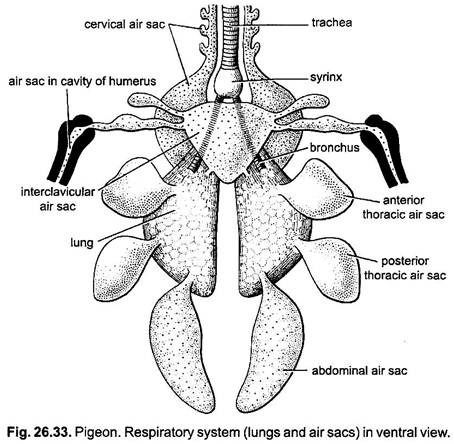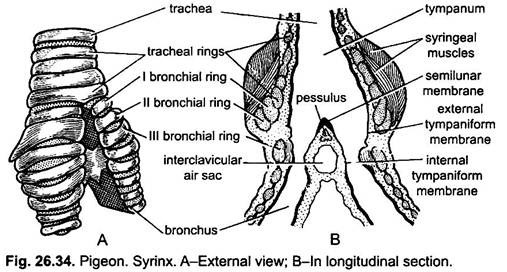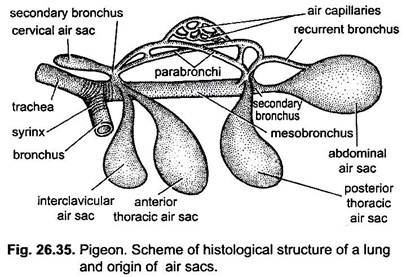The flight activity requires a continuous and abundant supply of oxygen, therefore, the respiratory system of birds is highly developed and well differentiated. Respiration is pulmonary and respiratory organs are simple. Muscular diaphragm in birds is lacking. The respiratory system includes the respiratory tract, the respiratory organs or lungs and the air sacs.
Respiratory Tract:
The respiratory tract includes nares, nasal sacs, glottis, larynx, trachea and syrinx.
(i) Nares, Nasal Sacs and Glottis:
The external nares or nostrils are a pair of slit-like oblique apertures occurring at the base of upper beak and are overlapped by a swollen sensitive skin, the cere. The external nares open into short olfactory or nasal sacs which remain communicated to the pharynx by internal nares or choanae. A median slit-like glottis lies behind the base of the tongue and it opens into the trachea. At the anterior end of trachea is present an expanded chamber, the larynx.
ADVERTISEMENTS:
(ii) Larynx:
The larynx is an expanded, voiceless chamber which occurs at the anterior most margin of trachea and is greatly reduced in birds. The larynx is supported by a triangular cricoid cartilage, formed of four pieces, two of which lying above are called procricoids present only in some birds. The larynx also has a pair of partly ossified curved arytenoids cartilages.
Thyroid cartilage found in mammals is absent. There are no vocal cords which are the characteristics of mammals, therefore, the larynx of birds does not function as a sound producing organ. Larynx opens into a long trachea.
(iii) Trachea:
ADVERTISEMENTS:
The trachea is a long, cylindrical and flexible tube running backward through the neck. It occurs beneath the oesophagus and is displaced to the left in the middle region by the crop. On entering the thoracic cavity it expands into a syrinx and then divides into two bronchi, one for each lung.
The walls of tracheal and bronchial tubes are supported by a series of closely-set rings. All the tracheal and the first bronchial rings are bony and completely surround the tube. While the bronchial rings are incomplete mesially and cartilaginous.
(iv) Syrinx:
ADVERTISEMENTS:
The syrinx is a vocal organ found only in birds. It is present at the junction of trachea and paired bronchi. It is an expanded chamber called tympanum. Its wall is supported by the last three or four tracheal rings and the first half-rings of the two bronchi. Its inner mucous membrane forms a cushion-like thickening on each side. At the junction of bronchi a bar of cartilage, called the pessulus, extends dorso-ventrally and supports an inconspicuous fold of mucous membrane, the membrana semilunaris.
The mucous membrane of inner walls of each bronchus forms an internal tympaniform membrane and an external tympaniform membrane associated with the outer wall. These tympaniform membranes enclose an interclavicular air sac just beneath the semilunar membrane.
The movement or functioning of tympaniform membranes is controlled and regulated by a pair of intrinsic syringeal muscles which arise from the sides of the trachea and are inserted into the syrinx, and a pair of sternotracheal muscles arises from the sternum and is inserted into the trachea.
The sound (voice) is produced by the vibrations of the semilunar membrane as the air is forcibly expelled from the lungs, during expiration, passes between them. The pitch of the voice is altered by sternotracheal and intrinsic syringeal muscles which change the tension on the semilunar tympaniform membranes and so the pitch of the sound. The syrinx is absent in ostriches and storks, etc.
Respiratory Organs or Lungs:
The lungs of pigeon are bright red, small, compact, slightly distensible, being solid, spongy, highly vascular organs. They differ from those of other vertebrates in that they do not store air. They lie in the pleural cavities which are separated from the peritoneal or abdominal coelom by an oblique septum.
The dorsal surface of the lungs is closely applied to the ribs and thoracic vertebrae and has no peritoneal covering. Their ventral surface is free and covered by a special fibrous peritoneal membrane called pleura or pulmonary aponeurosis. Small fan-like muscles called costopulmonary muscles arise from the junction of vertebral and sternal ribs and are attached to the pulmonary aponeurosis.
The bronchus entering a lung from the antero-ventral side does not branch immediately as in other tetrapoda and is called primary bronchus. Within the lung, it loses its cartilaginous rings and continues up to its distal or posterior end, and is called mesobronchus.
The mesobronchus gives off branches to air sacs and also gives off several secondary bronchi which may be distinguished as dorsal, ventral and lateral according to their position. The secondary bronchi (dorsal and ventral) then branch into tertiary bronchi or parabronchi.
ADVERTISEMENTS:
The parabronchi form an intricate system of branching and anastomosing thin-walled air capillaries forming loops and also join recurrent bronchi. The lung parenchyma has hexagonal areas, each has a central parabronchus, surrounded by a system of air capillaries and interlacing blood capillaries. Thus, parabronchi and air capillaries do not end blindly.
There is no dead space in the lungs. Each air capillary opens by both ends into a parabronchus. Alveoli are not found in the lungs. The air capillaries are lined with a vascular respiratory membrane and they come into contact with blood capillaries for an exchange of gases. In birds, thus, the branches do not have blind endings in alveoli as in mammals. They form an inter-communicating system of bronchi, parabronchi, and air capillaries forming complete air circuits in which air circulates.
Air Sacs:
From the mesobronchus arise secondary bronchi (dorsal, ventral and lateral), dorsal and ventral divide into parabronchi, but in each lung lateral secondary bronchi do not divide but pass through walls of the lung and enter the air sacs except the abdominal air sacs which are connected with the mesobronchus. The air sacs are, thus, dilations of the bronchi.
The air sacs are large, thin-walled membranous, non-muscular and non-vascular structures. They do not increase the respiratory surface and lie among the viscera and also extend into some of the larger bones. Their total volume is more than that of lungs and fills up much of the body cavity. Openings of bonchi into air sacs are called ostia.
From the anterior ends of air sacs arise small recurrent bronchi or sacco-bronchi, which connect the sacs with parabronchi and the air capillaries of the lungs. Cervical air sacs have no recurrent bronchi. The pure air is returned from air sacs into the lungs through these recurrent bronchi. Air sacs are paired but in pigeon, the two interclavicular air sacs fuse during early development. Pigeon has nine large air sacs and are named according to their position in the body.
(a) Interclavicular:
It is a median, unpaired, somewhat triangular air sac connected to the secondary bronchi of both lungs. It lies in between the angle of two limbs of the furcula. From each side of the interclavicular air sac arises two tubular auxiliary (axillary) air sacs, one of which enters the humerus bone through a pneumatic foramen as axillary or extra-clavicular air sac and a clavicular air sac.
(b) Cervical:
A pair of small cervical air sacs arises anteriorly, one from each lung. They lie at the base of the neck, dorsal to the interclavicular and alongside the vertebral column. They give out minor saccular branches in the neck.
(c) Anterior Thoracic:
From the side of each lung arises an anterior thoracic air sac which lies at ventral side of lung in the anterior portion of the thorax, in close contact with the ribs and the pericardium. Each extends back and overlaps the posterior thoracic air sacs. Its ventral wall remains covered by the oblique septum.
(d) Posterior Thoracic:
A pair of small, posterior thoracic air sacs is found in the posterior part of the thoracic cavity just in front of abdominal sacs. Each sac overlaps the posterior end of its lung and communicates with its outer posterior angle.
(e) Abdominal:
From the distal end of each lung arises a large abdominal air sac. Each abdominal air sac lies along the dorsal wall of the abdomen, ventral to the kidneys, amongst the coils of the small intestine.
Functions of Air Sacs:
The air sacs are thin reservoirs of air which communicate with bronchi on the one hand and with the pneumatic cavities of the bones, on the other hand.
They serve the following functions:
i. Accessory Respiratory Organs:
The air sacs are not respiratory organs but they help in respiration. They act as bellows forcing their air into the lungs for ventilation at each expiration to completely renew the air in the lungs, thus, there is no “dead space” of unrespired air in the lungs.
But, it is claimed that the anterior air sacs are expiratory (interclavicular, cervical and anterior thoracic) and they are more active during flight. The posterior air sacs are inspiratory (posterior thoracic and abdominal), they are more active when the bird is not flying.
ii. Lightness:
The air sacs also act as balloons giving buoyancy in flight and reducing the specific gravity of the bird due to the contained warm air. This view is no longer supported now.
iii. Temperature Regulation:
The air sacs also help to maintain and regulate body temperature acting as a cooling device by losing body heat through internal evaporation, i.e., water vapours diffuse from the blood into cavities of air sacs and pass out through the lungs, accompanied by loss of body heat.
iv. Cardiac Movements:
According to Muller (1908), the air sacs allow movement to the heart in a very rigid thorax.
v. Flight:
The best flying birds possess most highly developed air sacs which confirm their association with flight.
Respiratory Mechanism:
In pigeon and other birds the expiration is an active process and not inspiration as in other vertebrates. The lungs have a large internal respiratory surface.
i. Breathing at Rest:
In a resting pigeon during inspiration, the respiration is brought about by costopulmonary or intercostal muscles (inspiratory) which lowers the sternum, the air sacs expand and the lungs are compressed, thereby increasing the thoracic and abdominal cavities. It reduces the pressure on the lungs.
Air is drawn into the posterior air sacs through the mesobronchus. At the same time air present in the lungs enters into the anterior air sacs. Thus, in inspiration a large amount of air goes from secondary bronchi into the air sacs.
Expiration is brought about by movements of abdominal muscles (expiratory) which raises the sternum compressing the air sacs and expansion of lungs. By compression of posterior air sacs their air is forced into the lungs through recurrent bronchi, and the stale air of anterior air sacs enters the mesobronchus, trachea and finally out through the nostrils.
ii. Breathing during Flight:
During flight, the sternum and ribs become immovable to brace the wings, and the ordinary method of inspiration and expiration by intercostal and abdominal muscles respectively is abandoned. The air movements in and out of the lungs are done by the elevation and depression of the back with the help of the wing’s strokes. The faster a bird flies, the more rapid is the air circulation and gaseous exchange in the lungs.
In birds the air is constantly renewed and passes several times over the respiratory epithelium of air capillaries, because of intercommunicating system of tubules. The aeration of blood is absolutely complete, allowing a high degree of muscular efficiency and maintaining a high body temperature which ranges from 102° to 111°F (passerine birds).


